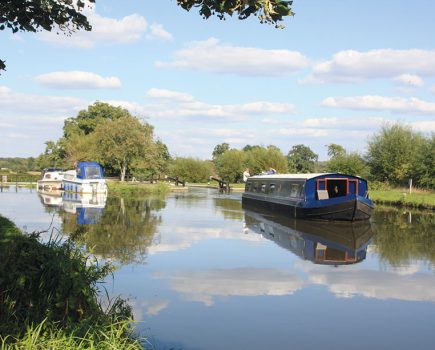We think of autumn colours as going from green to brown, but the drakes have a different idea, says Pip Webster

“Everyone must take time to sit and watch the leaves turn.” So said the author Elizabeth Lawrence.
From tired greens to shades of ochre, autumn can be a beautiful season with its many moods and carpets of fallen leaves – lovely to scrunch through, though not such fun to clear off your narrowboat.
Wild cherry and dogwood in the hedgerows stand out in shades of pink, red and crimson, while most of our native British trees turn yellow or brown. The small lobed leaves of field maple turn a particularly vibrant yellow and the more subtle ash turns light green, then yellow.
Ash leaves can fall suddenly, leaving the tree still holding on to bunches of ash ‘keys’ (dry brown winged seeds) on its bare branches. The opposite extreme is seen in beech, where the tree hangs on tenaciously to its orangey-bronze leaves often through to the winter.
Shorter days trigger the production of the glorious autumn colours. Water is lost through the broad leaves of deciduous trees and available water can be surprisingly scarce in the harsh winter months when the ground is frozen.
Sunlight to synthesise sugars is often in short supply, so the tree loses its leaves and becomes dormant. The green colour fades away as chlorophyll (the chemical responsible for capturing the energy of sunlight) is broken down, revealing the underlying yellows and oranges of the more stable carotene pigments. The tree resorbs many useful chemicals before a corky abscission layer eventually seals off the leaves from the twigs and the leaves fall.
The most spectacular autumn colours are produced when dry sunny days are accompanied by cool, crisp nights. Late high levels of sugar facilitate the synthesis in some species of anthocyanins, with their deeper red and purple colours. Sealed off in the dying leaf, they add spectacular colour to autumn: “A second spring when every leaf is a flower” (Albert Camus).
The reverse
But while leaves turn from green to brown, male mallards do the reverse, emerging from their moulting or ‘eclipse’ plumage by the end of September to sport those magnificent glossy dark green heads.
It is one of several methods employed to attract the attention of the still drab-looking females. Although serious pairing often does not occur until early spring, you can still enjoy watching courtship displays in the autumn months.
The drakes flick their heads and jab their bills into the water, splashing and showing off their black, curled tail feathers. When approached by a female, the drake often responds by tucking his head down to his chest and rearing the front half of his body right out of the water and emitting a low grunt, immediately followed by a whistle.
Drakes can utter an occasional wheezy quack, but only the females produce that series of noisy but diminishing nagging sounds like a belly laugh.
Our resident British mallards are joined in October by migrants from Iceland and northern Europe. The males tend to arrive first, leaving the females completing the task of rearing the previous season’s young.
Mallards are the species most often called ‘wild ducks’, but that statement is a real etymological tangle. ‘Ducks’ are female. ‘Mallard’ is thought to derive from the old French ‘malart’ for wild drake (male) and originally referred to any species of wild drake.
They are dabbling ducks – shallow water ducks that feed primarily along the surface or by tipping headfirst into the water. The inside of their beaks have tiny rows of plates (lamellae) through which they can filter the water, trapping food.
Mallards are omnivorous, eating plant matter, insects and worms. They dive infrequently – often just to avoid predation – and are equally happy grazing on the land.
You have probably noticed the roughness of a mallard’s beak if you have been nipped by one when it takes food from your fingers.
___________________
You may also like:
Wildlife on the waterside: butterflies
8 bat species to look out for on British waterways
Image(s) provided by:
Archant







